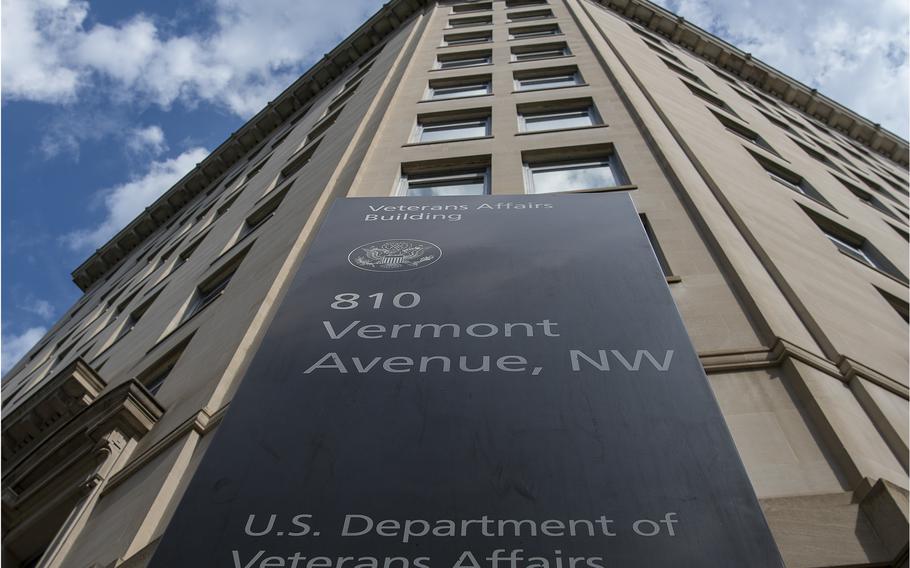
A $15 billion budget shortfall that the Department of Veterans Affairs requested from congressional lawmakers for emergency funding to cover veterans benefits does not exist, House lawmakers said. (Stars and Stripes)
WASHINGTON — A $15 billion shortfall that the Department of Veterans Affairs disclosed to lawmakers in an urgent request for emergency funding to cover veterans benefits and close the projected budget gap does not exist, House lawmakers said Friday.
VA leaders told Congress in September that they needed $3 billion immediately to close a budget gap or veterans would lose their monthly benefits on Oct. 1, the start of fiscal 2025.
Instead, the VA has a surplus of $5.1 billion from fiscal 2024, according to Rep. Mike Bost, R-Ill., chairman of the House Veterans’ Affairs Committee, and Rep. John Carter, R-Texas, chairman of the committee’s subpanel on military construction, veterans affairs and related agencies.
The VA also no longer projects a $12 billion shortfall for fiscal 2025. Higher costs for an increase in health care enrollments, payroll and equipment purchases all fell within original budget estimates, the lawmakers said.
“No benefits shortfall ever existed, and much of the information your leadership team has provided about a purported health care shortfall is erroneous,” Bost and Carter wrote in a sharply worded letter sent Friday to VA Secretary Denis McDonough.
The lawmakers accused VA leaders of “an utter inability to forecast and determine costs accurately.”
“For the sake of veterans’ and taxpayers’ remaining confidence in the VA, we urge you to come clean about this situation,” Bost and Carter wrote in the letter.
They requested the VA retain and forward all communications and documents related to actual or potential shortfalls for fiscal 2024 and 2025 for further review by Congress.
The lawmakers wrote they received more detailed information on VA finances this week after they made a request Sept. 27 for the agency to reconcile accounts for fiscal 2024 before Congress would consider providing additional funding to cover a projected shortfall in 2025.
Congress adopted the Veterans Benefits Continuity and Accountability Act in September that provided $3 billion in additional revenue for 2024. The dollars were to enable the VA to cover immediate monthly payments for 7 million veterans and their survivors.
If the measure failed, VA leaders had warned disabled veterans and their beneficiaries could wait weeks to receive compensation that was supposed to be delivered Oct. 1.
Joshua Jacobs, the VA undersecretary for benefits, told lawmakers in September that the VA had validated its forecast before disclosing the information to Congress.
In a statement sent this week to Bost and Carter, the VA distanced itself from earlier warnings about shortfalls.
The VA said in a written statement that its request for funds at the end of fiscal 2024 was “a conservative estimate to avoid a worst-case scenario.”
The agency also said it did not use the roughly $3 billion in emergency appropriations that Congress provided in mid-September but will apply those funds in fiscal 2025.
“While the supplemental funding was not immediately utilized, it was critical that we had this funding on hand because if we had even been $1 short on Sept. 20, we could not certify our payments” to veterans, the VA said. “Any delay could have been devastating.”
The VA had told Congress that it needed the supplemental funds by that date to make monthly payments to veterans and their beneficiaries on Oct. 1.
Because the VA purchased more prescription drugs and medical equipment than it needed in 2024, the VA is no longer projecting a shortfall in 2025 driven by a higher demand for medicine and supplies.
“We also obligated more in [fiscal] 2024 than projected in the [fiscal] 2025 budget in supplies and materials for drugs and prosthetics,” the VA said in its written statement.
But the VA also cautioned lawmakers that VA spending in 2025 could still exceed original estimates. The agency stated it expects to hire 5,000 additional staff and is projecting a “funding anomaly” by the end of the calendar year.